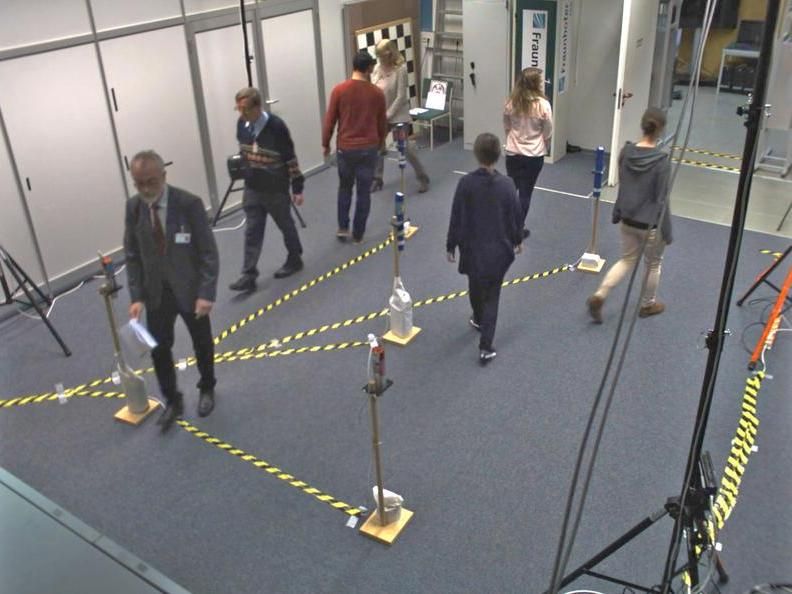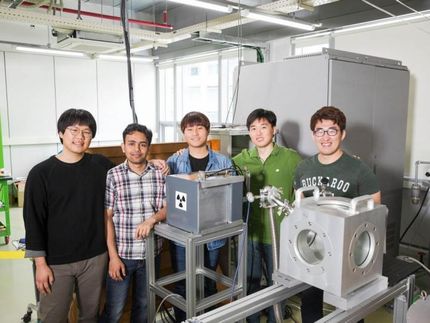How to combat radiological weapons
Safety assistance system warns of dirty bombs
The threat of terrorism in Europe has been on the rise in recent years, with experts and politicians particularly worried that terrorists might make use of dirty bombs. Fraunhofer researchers have developed a new system that will be able to detect possible carriers of radioactive substances, even in large crowds of people. This solution is one of many defensive measures being realized in the REHSTRAIN project, which is focused on security for TGV and ICE high-speed trains in France and Germany.

Lab testing at Fraunhofer FKIE to see how robust the security assistance system is: it must be able to clearly identify the carrier of a dirty bomb without sounding a false alarm.
Fraunhofer FKIE
For a long time, experts have been warning of attacks using dirty bombs, where terrorists mix radioactive material into conventional explosives such that it is scattered by a subsequent explosion. This is a real danger; ISIS, for instance, claims to have access to radioactive material. Security agencies are aware of the threat: last June, a U.S. port terminal in Charleston was evacuated and closed for several hours following a warning that a dirty bomb was on board a ship moored there. Once the all-clear was given, security personnel stated that they were being deliberately overcautious and had reacted accordingly.
Dirty bombs are not a form of nuclear weapon, since they do not rely on a nuclear chain reaction occurring after they have been set off. The radioisotopes needed to make dirty bombs, such as cesium-137, cobalt-60, americium-241 or iridium-192, are easier to get hold of than fissile material for nuclear weapons; they are used in many nuclear medicine departments at hospitals and in research centers, but also for ma-terials testing in industry. “Five grams of cesium – scattered by a couple of kilograms of explosive – is enough to cause billions of dollars’ worth of damage, to say nothing of the psychosocial effects and the impact on health. People who want to build these bombs are risking death through exposure to radiation – but that is unlikely to deter terrorists,” says Prof. Wolfgang Koch, a mathematician and physicist who heads the sensor data and information fusion department at the Fraunhofer Institute for
Communication, Information Processing and Ergonomics FKIE, based in Wachtberg, Germany. Fraunhofer FKIE has developed an assistance system capable of detecting radiological threats in a stream of people and warning security personnel; this is the institute’s contribution to the Franco-German REHSTRAIN project, which is researching the vulnerability of ICE and TGV high-speed trains (see box: “The REHSTRAIN project at a glance”). Fraunhofer FKIE is developing the system as a subcontractor to Hochschule Bonn-Rhein-Sieg.
Data protection writ large
The assistance system comprises several components: a sensor network, commercially available Kinect cameras, and data fusion software. The sensor network is made up of gamma spectrometers, which detect and classify gamma radiation. “Most of the materials that lend themselves to being used in a radiological bomb emit gamma radiation, which cannot be shielded. That’s why we use this kind of sensor,” Koch explains. The next phase of the system will be able to tell which substance is emitting the radiation, and whether it is being carried on someone’s person or is present inside their body – perhaps because they are on medication such as radioactive iodine. Although individual sensors can provide data on the type of material and the intensity of its radiation, they cannot pinpoint its location. This calls for a network of gamma sensors connected to Kinect cameras as used in the gaming industry. The advantage of these cameras is that they provide not only images but also information about distances. Mounted on the ceiling, they record groups of people like a hilly landscape, which means they can precisely track even the busiest streams of people. “We know at any given point in time where each person is located. But of course, we don’t know their identity – and that is an essential consideration for data protection,” Koch adds. Biometric tracking of potential terrorists should be undertaken only when there is sufficient reason to do so.
System clearly identifies carriers of dangerous substances
Once these devices are connected to each other, they can record people in both time and space, and their data fused. Sophisticated mathematical evaluation algorithms then filter out the desired information from the huge amounts of data. “We use artificial intelligence to do this. The algorithms help us calculate the movements of the only person with whom the gamma sensor readings can be correlated. That identifies the potential attacker,” Koch explains.
If they were applied at critical spots – in entrance areas and approaches to railway stations and airports or other public buildings – assistance systems of this sort could report information about radiological threats to, say, transportation company surveillance systems. The question of who has access is one for security personnel and the police.
Fraunhofer FKIE has been granted permission to experiment with weak radioactive substances, and has already successfully tested its system in the laboratory under the supervision of a radiation control agent. REHSTRAIN has been officially presented as part of a project workshop at FKIE, which in addition to partners from Germany and France was also attended by potential end-users.
These products might interest you
See the theme worlds for related content
Topic world Sensor technology
Sensor technology has revolutionized the chemical industry by providing accurate, timely and reliable data across a wide range of processes. From monitoring critical parameters in production lines to early detection of potential malfunctions or hazards, sensors are the silent sentinels that ensure quality, efficiency and safety.

Topic world Sensor technology
Sensor technology has revolutionized the chemical industry by providing accurate, timely and reliable data across a wide range of processes. From monitoring critical parameters in production lines to early detection of potential malfunctions or hazards, sensors are the silent sentinels that ensure quality, efficiency and safety.































































